18 Oct 2024 Fêtes of Anlaby Past
Admiring the Legacy of Anlaby’s Garden Fêtes: A Journey Through South Australian History

The 10-acre garden at Anlaby Station, one of the most historic gardens in South Australia, has, for more than a century, opened its enormous iron gates, allowing visitors to indulge in the captivating scents, sounds, and sights on offer.
One of the earliest garden fêtes was held on 24 October 1906. The garden was opened to members of the public to raise funds for the construction of the St Matthew’s Parish Room in Hamilton. The proceedings were inaugurated by Governor Sir George Le Hunte, who paid tribute to the hard-working members of the St. Matthew’s congregation. Visitors were entertained by a variety of attractions, including gramophone concerts, a shooting gallery, games of ‘Aunt Sally’ (a traditional English game where players throw batons at a ball balanced on top of a stick, often fashioned to look like an old woman’s head), and more.
Two white marquees were erected on the tennis lawn for afternoon tea, which proved hugely popular. One report exclaimed that crowds constantly besieged the tables, giving the ‘afternoon tea ladies’ an arduous time! A musical program presented by the Kapunda Brass Band delighted visitors. They were also invited to tour the Clydesdale stables, dog kennels, and conservatories. The fête coincided with the annual shearing season, and several visitors availed themselves of the opportunity to not only marvel at the Woolshed but also witness machine shearing, as it was the first time machine shearing was undertaken at Anlaby.
One of the most recent additions at Anlaby that year was a flagstaff, erected north-east of the main house. It was richly decorated with bunting and allowed those brave enough to ascend around 20 meters a magnificent view of the estate. One correspondent noted that “one’s nerves [were] tested by the strong wind, which flapped the flags and shook the staff, giving an uncanny feeling to many.” An unnamed photographer braved the ascent and captured the day superbly:

The immense success of the 1906 fête laid the foundation for future events. Anlaby’s garden was opened annually to support local causes, and Henry Dutton was able to entertain guests in his personal garden utopia.
For the 1907 fête, Henry Dutton once again threw his support behind St Matthew’s Parish Room, Hamilton. He personally drove guests up and down the mile-long eucalyptus avenue to raise funds for the cause. Riding in a car was such a novelty that guests lined up for nearly three hours to experience the sensation! For those not keen on riding in a car, wagon trips were available between the homestead and the woolshed, and, of course, there was the extensive garden to explore.
A newspaper correspondent who attended the 1908 fête provides a fantastic insight into how these fêtes operated: “The motor-car trips with the three cars were an immense attraction. The excursions were under the direction of Mr. Harry Dutton and Mr. Claude de Neufville Lucas, assisted by the two Anlaby chauffeurs, and there was a constant stream of fares for the two hours or more that the cars ran. Mr. Henry Dutton was busy in his genial way in seeing that the visitors were being entertained. Saloon-rifle-shooting and Aunt Sally found many who were prepared to try their skill in the use of a steady eye and straight aim. The conservatories were largely patronised, the orchid house, ferneries, and grotto receiving a continuous visitation. The cinerarias are a lovely sight, but the pelargoniums are only just in the bud stage, the season being rather late. The cucumber house, where appetising fruit hung from the trellis in numbers, was also an attraction. In the vine house, where the luscious berry is grown under artificial temperature, there are large bunches of fruit, which will be in the ripening stage in a few weeks’ time…On the eastern side of the residence, the beautiful trellis of Wistaria is still in flower, and the huge clusters of heliotrope bloom were greatly admired.”
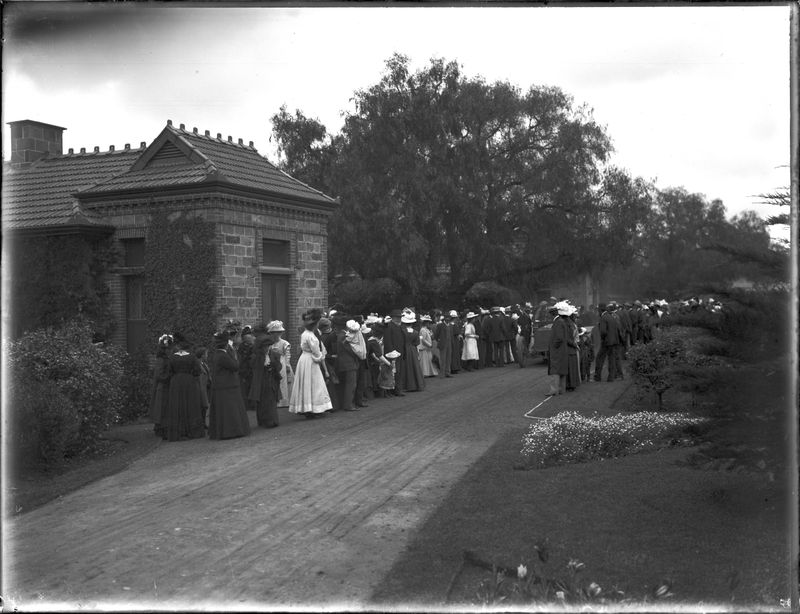

In 1909, the Governor of South Australia, Admiral Sir Day Hort Bosanquet, opened the Anlaby Fête. Having toured the countryside surrounding Anlaby, he paid tribute to the intense agricultural efforts visible all around, noting the work done by the able hands of many local farmers. The 1910 and 1911 fêtes followed a similar pattern: the garden was opened for guests from far and wide, and there was much positive commentary on Mr. Dutton’s geniality and generosity.
An account from 1912 gives us an idea of the rich botanical offerings on view during a fête at Anlaby: “The terraced garden is an ideal place to hold a fête, with its wonderful variety of plants and shrubs. The hot-houses proved to be a great attraction, with their ripe cucumbers and bunches of luscious grapes, peeping from their green setting of leaves and tendrils. The cucumbers especially proved such a novelty that the price of one shilling set upon each did not in the least retard their sale. The amusements provided for the visitors included motor car rides, a shooting gallery, ‘Aunt Sally’ and a string band, while sweets and refreshments were retailed by the ladies. The three cars (one of which Mr Dutton drove) were kept busy.” For the first time, visitors also had the chance to ascend the recently completed water tower.
No garden fête was held in 1913, likely because the cost of building St Matthew’s Parish Room had finally been covered. This brought an end to the annual run of garden fêtes that had started so auspiciously in 1906. Nevertheless, on 1 November 1915, Anlaby once again hosted members of the public from near and far. This time, the fête raised over £500 for the Wounded Soldier’s Fund and the Kapunda branch of the Red Cross Society. Raising funds to aid wounded soldiers was important to the local community, as many men and women had answered the call to serve, and some had already paid the ultimate sacrifice. At Anlaby alone, 17 men joined the cause, and six never returned. The fête was opened by Lady Marie Galway, wife of the Governor of South Australia, a dedicated charity worker and women’s rights advocate. She was also the first president of the Red Cross Society in South Australia. This momentum to raise funds for war-related causes continued into 1916 when a Red Cross fête was held to support various war efforts.
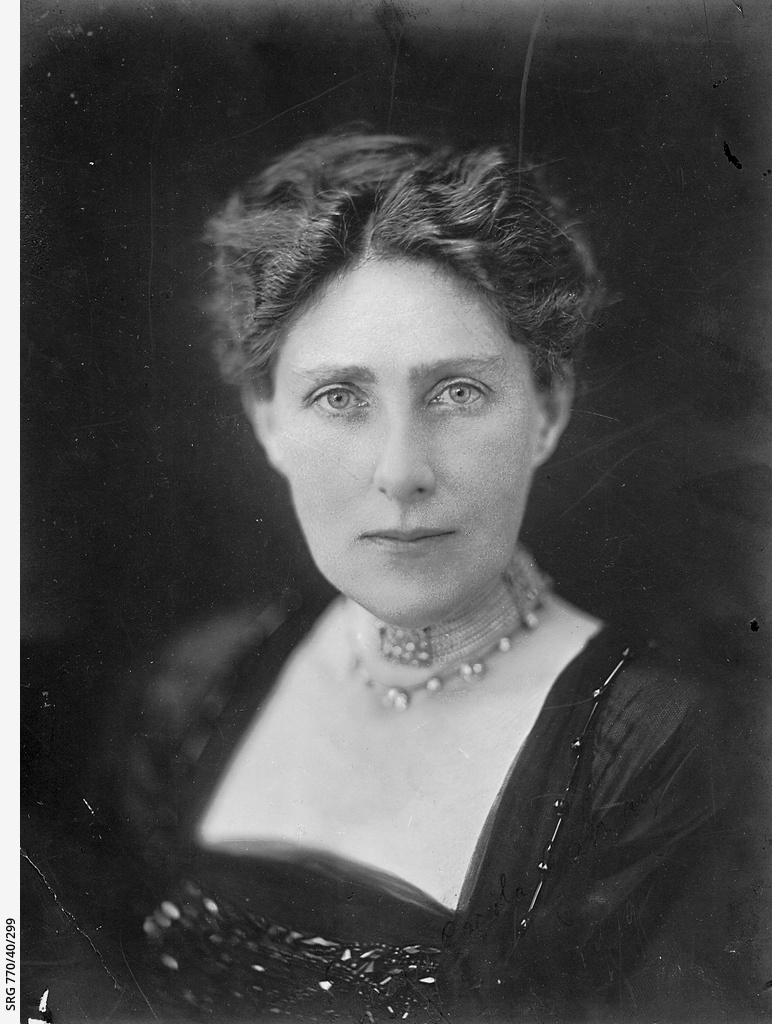
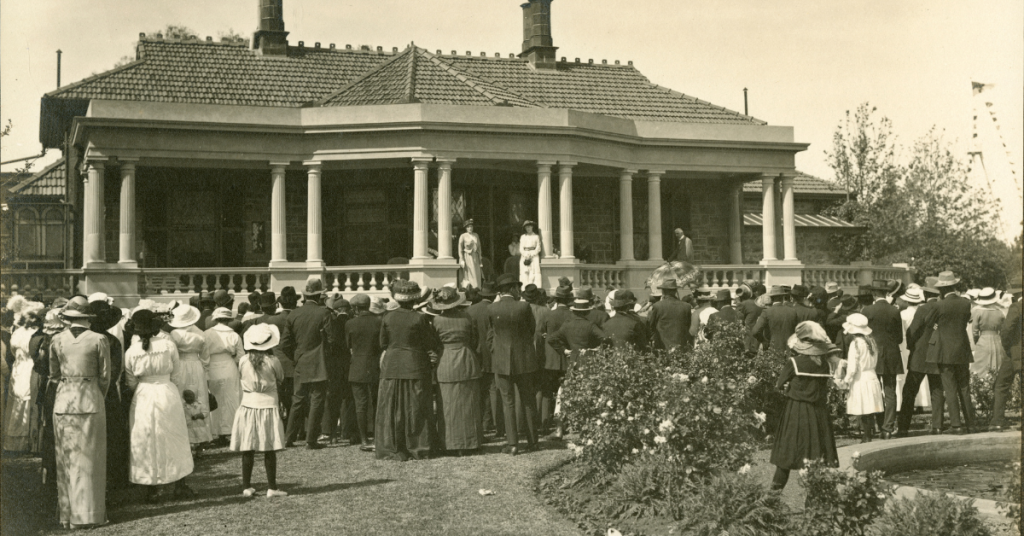
In 1924, the gates at Anlaby were once again opened to aid a local fundraiser—this time for the Kapunda Hospital. The day was opened by Lady Bridges, wife of the Governor of South Australia. She stood at the top of the stairwell on the recently constructed Italianate façade on Anlaby’s southern side, making it the first time members of the public could admire this imposing and elegant addition.
In 1935, a garden fête was held at Anlaby to raise funds for St Matthew’s Church and Parish Room, Hamilton. Cars arrived from all directions to view the garden. ““Just after entering the gate, a mass of ranunculi, antirrhiniums, and other flowers met the eye, while beautiful forget-me-nots were in profusion as the main garden was entered. Wistaria, clematis, roses, beds of iris, lilac, and many other beautiful shrubs, trees and flowers were seen as the inspection of the garden proceeded, and expressions of admiration were heard on every side.” On the oval, a cricket match took place between the Eudunda and Hamilton clubs. Afternoon tea was offered, along with flowers, ice cream, cool drinks, sweets, cakes, bran dip, games, and produce. That evening, a dance was held in the Woolshed, which was well attended. Over £90 was raised during the day.
On 19 October 1936, the garden gates opened again to support a local resident, Miss Violet Poole, with her entry into the Miss Centenary competition as part of South Australia’s centenary celebrations. Two years later, in 1938, the garden was opened to the public -this time by Sir Stanton Hicks, a distinguished professor of pharmacology – to raise funds for St. Matthew’s Church in Hamilton.
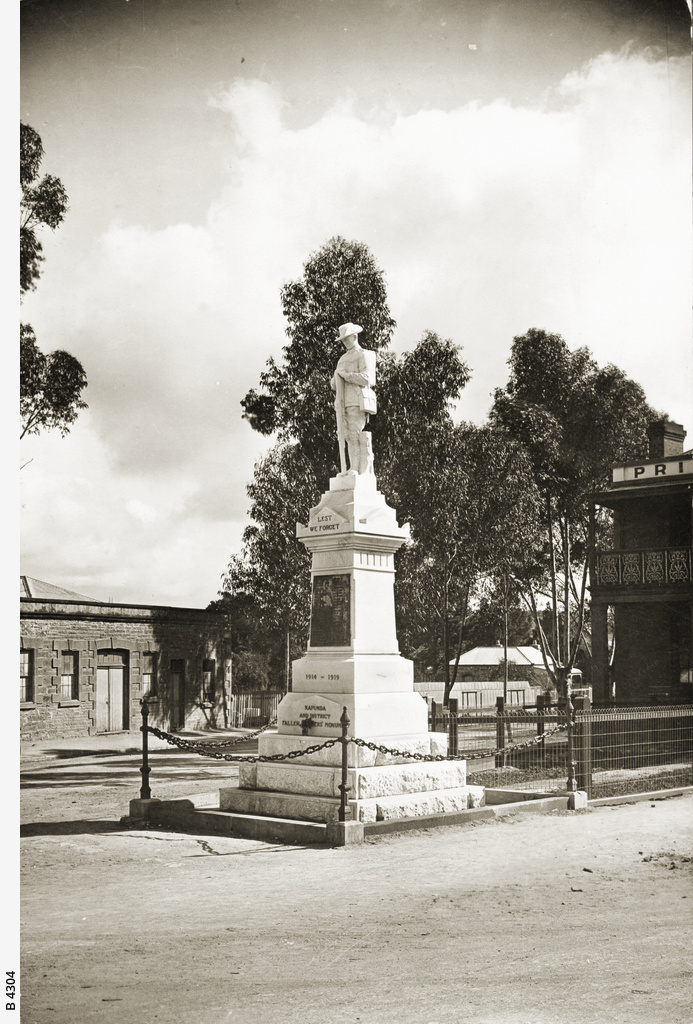
In October 1946, the garden at Anlaby hosted another Garden Fête. A wide variety of stalls, games, food, and beverages were offered, including afternoon tea, which was ably overseen by ladies from the Hamilton district. This fête had a particular aim: to raise funds for the Kapunda and District War Memorial. The districts surrounding Kapunda had been asked to raise funds for the memorial, and Hamilton used this garden fête as an opportunity to reach their fundraising target.
Fêtes at Anlaby were an important feature on the annual calendar. They provided opportunities to raise funds for local causes, whether for a parish room, a war memorial, or war relief efforts. The community could come together for a day of frivolity and delight to enjoy a garden utopia par excellence. The fêtes were also an opportunity for Henry Dutton, his successor Harry Dutton, and his wife Emily Dutton to demonstrate the latest addition to the garden or house and display the most creative aspects of garden design. This included the construction of the water tower, the erection of the flagstaff, or the redesign of the homestead’s Italianate façade in 1924. The Dutton family’s engagement in these events highlighted their close connection to the local community, avoiding the image of aloof aristocracy.
In 1946, Anlaby hosted its last great fêtes before a very long gap. As it became increasingly difficult to maintain the extensive garden through the 1950s and beyond, parts of the garden succumbed to neglect. The property passed through several owners during this time, none of whom had the resources to fully restore it.
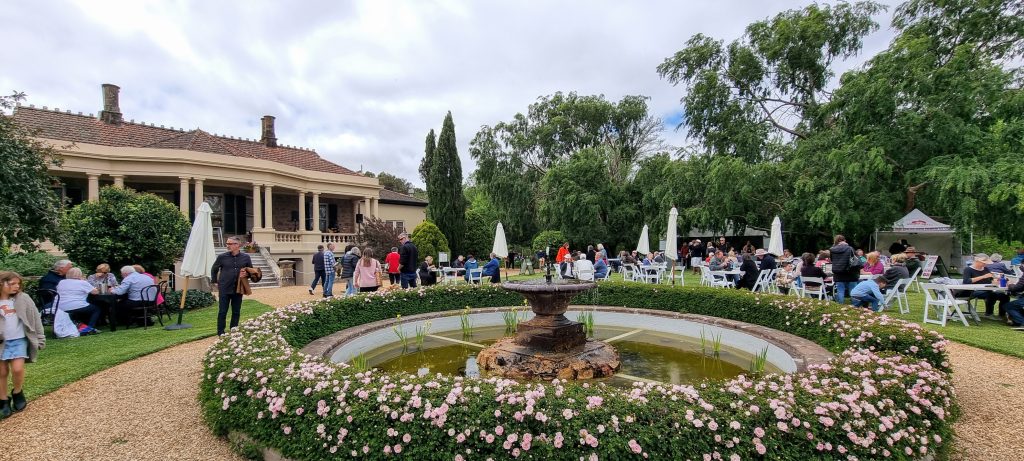
However, in 2012, the idea of opening Anlaby’s garden to the public was resurrected by the current owners, Andrew Morphett and Peter Hayward. Their ongoing aim has been to showcase the rejuvenated heritage garden and celebrate the rich history of unique garden design on the estate. The opening of the gardens presented an opportunity to raise awareness of Anlaby—its significance had faded over the years—and generate much-needed funds for ongoing restoration work. Though the purpose of the festivities has changed from the original 1906 fête – from supporting a charitable cause to raising funds for restoration – the garden has remained at centre stage: open for all to come and admire the beauty and bold vision on display.
During our upcoming Spring Festival, we are excited to unveil the newest addition to Anlaby’s grounds: a stunning Oriental-inspired garden, created to celebrate Anlaby’s 185th anniversary. This garden gift to the property features intricate dry stone creek beds, delicate bridges, and a tranquil atmosphere that recalls the serene beauty of Monet’s garden. The official opening of this beautiful new space will be one of the highlights of the festival, and we invite you to join in celebrating this exciting milestone for Anlaby.
Festival-goers will also have the chance to sample a smorgasbord of delights—from our famed Devonshire Tea and French champagne to the best lamb pies around and a crisp Gin & Tonic. Carriage rides through the grounds—including some exclusive behind-the-scenes areas—will be available, and market stalls will provide an opportunity for some early Christmas shopping. We’ll also feature a line-up of fantastic speakers in the Sundial Garden, along with kids’ activities, plenty of coffee, and guided tours to explore the magnificent gardens first established more than 160 years ago.
Whether you’re a lover of South Australian history, a fan of unique heritage gardens, or simply looking for a relaxing day out, the Anlaby Spring Festival has something for everyone. Come for the gardens, stay for the food, and enjoy a glimpse into the past while helping secure the future of one of the region’s most iconic estates.

